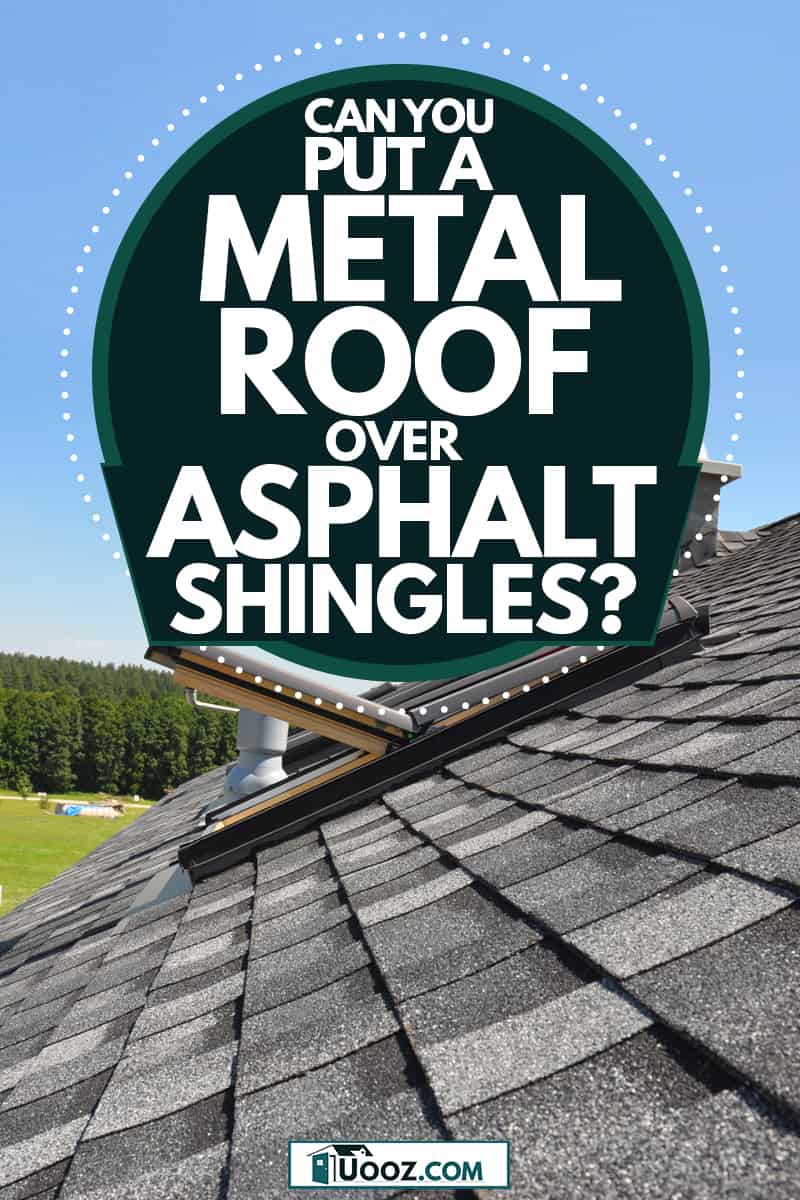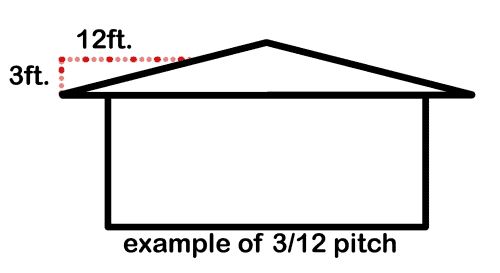Metal roofing has become a popular and attractive alternative to asphalt shingles. With more color and design options than ever, it is only expected to grow in popularity. But one question many people may have is whether you can install it directly over asphalt shingles. We looked into it and found answers for you.
Metal roofing can be installed directly on top of asphalt shingles. However, to do so, you must meet the following requirements:
- Local building code -- in some areas, you can install over asphalt shingles, but some building codes do not allow it.
- The current roof must be in stable condition, with no rot, significant dips, or severe crowning.
- Must meet minimum pitch requirements for your chosen metal roofing, with a typical lapped seam requiring a 3/12 pitch.
Metal roofing can provide for many years of service, with very low maintenance. But there are both pros and cons to consider. We dig into some of these details, so keep reading.

Metal Roofing Vs. Asphalt Shingles
About fifteen percent of homes currently have a metal roof, with the number growing all the time. But if you are deciding whether to install metal roofing or asphalt shingles, you should weigh the pros and cons of each.
Metal Roofing
Pros:
- Durability -- lasts 2-3 times longer than asphalt shingles
- Metal is lighter, putting less load on your structure
- Better in heavy winds
- Handles snow, rain, almost any weather condition well
- Fire resistant
- More resistant to hail than asphalt
- More color and design options
- More energy efficient
- Recyclable
Cons:
- Costs many times what asphalt costs to purchase and install
- More difficult and costly to repair if damage does occur, such as from very large hail
Asphalt Shingles
Pros:
- Style -- some people prefer the look to metal roofing
- Proven track record
- Ease of installation -- DIY friendly
- Wide availability of installers, whereas installing metal roofing is more specialized
- Very affordable
Cons:
- Not as durable
- More difficult to recycle when removed
- Less color and style options compared to metal roofing
- Less fire resistant
- Heavier than metal roofing
There are several advantages and some disadvantages to either roofing material. The metal is more durable and may last fifty years or more, compared to less than half of that for asphalt shingles. However, the metal roofing is significantly more expensive, and that added cost can be a barrier to some homeowners.
You can reduce the added expense for installation by installing new metal roofing directly over existing asphalt shingles, but this is not always possible. Where building codes permit it, they may vary on how many layers you can install over. Some locations only allow over a single existing layer, others over two. Because of this, it is important to check your local building codes carefully.
Do I Need Underlayment For Metal Roof Over Shingles?
When installing metal roofing over asphalt shingles, there are a couple of options.
Directly On Top Of Shingles, No Underlayment
If the roof is relatively level and in sturdy condition, you can install directly on top of shingles without underlayment, but it is not recommended. Problems may arise when doing this.
You can't be certain what condition the roof under the asphalt shingles is in unless you tear away the old shingles to get a good look. There may be weak or rotting boards, which may not hold the screws for the metal roofing.
The main, most important reason not to install directly on top of asphalt shingles with no underlayment is that the asphalt shingles will wear away the back of the metal roofing. This can expose bare metal, allowing it to rust. Expansion and contraction from heat cycling can cause the metal to slide back and forth against the asphalt shingles. When this happens, the rock on the shingles acts like sandpaper against the metal.
Proper Underlayment Below Metal
This method works well, as long as you inspect the roof well first to make sure the existing sheathing under the shingles is in good condition. Using underlayment in this method will act as a buffer between the shingles and the metal, preventing the shingles from sanding at the back of the metal roofing.
This method is much cheaper than having the shingles removed. The current shingles also will not go into a landfill this way. Instead, they remain in place. By staying in place, the shingles provide additional insulation to the roof. It's a small amount, but a nice added benefit of this method.
The downside to leaving the shingles in place is that it may not provide the evenest surface for the metal to screw down. In some cases, you can see dips from the uneven asphalt layer showing through to the metal. Textured metal roof materials, as well as metal shingles, can minimize some of this concern.
Install On Battens
Battens are wooden strips that you install over the old shingles, providing a more even surface for the metal roofing to sit on. But not all metal roofing can be installed on battens, so you will need to check the roofing you choose to make sure it can be used this way.
If installed properly, battens can add ventilation behind the roofing to help keep heat out of the attic. But they do add cost. They also suffer the same problem that the wood underneath the existing shingles must be sturdy enough to attach the screws that hold the battens in place firmly.
Keep in mind, even with battens you will need a good underlayment installed below the metal.
How Many Layers Of Shingles Does Code Allow?
In most places, building codes allow for up to two layers of shingles. This regulation allows you to place a second layer over an existing layer of shingles. Layering saves the expense of removal and the need to fill a landfill with tons of old shingles.
Some locations allow you to add a third layer, especially if the pitch of the roof is steeper. Adding this many layers adds a lot of weight to your roof, and the nails holding your third layer may not penetrate all the way to the wood underneath.
You will have to check local building codes to verify before you add any additional layers.
What Is The Best Way To Install A Metal Roof Over Shingles?
The most often used and popular method, if there are no problems with the wood underneath your existing shingles, is to place underlayment on top of the shingles, then screw the metal over top of that. In most cases, battens are not applied.
There are cases when underlayment over shingles is not recommended. If the existing asphalt shingles are wavy or curling, it may show through the metal when finished. If that is a concern, you may want to use battens. If there may be damage to the wood under the shingles, remove the shingles to repair the wood before installing the metal roofing.
Tear-off Vs. Overlay Roof; Which Is Cheaper?
Tear-off is cheaper than an overlay, usually. The cost of labor and disposal for tearing off a roof can add $1,000 or more to the price of a project. Long term, it may not save that much, because the overlaid roof may wear out and need replacing sooner.
Can You Put A Metal Roof On A Low Slope?
Yes, you can put a metal roof on a low slope. The lowest recommended with most types of metal roofing is around 3/12. That means for every 12ft inwards from the edge the roof must rise 3ft. This slope works out to about a 14-degree angle.

Different types of metal roofing will handle an even lower slope than this. Some metal roofing will work as low as 1⁄4/12 pitch. This works out to around a 1-degree angle. The metal roofing that works best at this low of a slope is one that has sealed seams. This angle of slope usually involves a sealant, mechanically seamed together to provide compression on the bond.
Are Metal Roofs Impact Resistant?
Metal roofs are very impact resistant. They will hold up without damage in hail storms that will often require a complete replacement of asphalt shingles.
They are not impervious, however. There is always the possibility of dings or dents from large hailstones. Dents rarely compromise the integrity of roofing but may be visible. There have been many cases of golfball-sized hail resulting in no visible damage to the roof.
Some insurance companies will now give discounts for a metal roof because there is a lower chance of having to replace the roof from storm damage.
What Is The Best Color Metal Roof For Energy Savings?
White is the most energy-efficient if you are only considering color. There are pigments used with the darker colors that help them reflect a part of the heat they usually would not, though. Even then, a very dark roof won't get near the heat reflectability of white.
A well-ventilated roof is less of an issue. A well-insulated roof and attic may also seal out some of the heat. In this case, the color will be less critical.
There is also the possibility that you live far enough north that most of the year is cooler, and you would rather be collecting the extra heat instead of reflecting it. In a colder climate, it may be beneficial to have a dark roof because of this.
Overall, metal roofs are already more energy-efficient than asphalt shingles, so whatever color you choose is an improvement over them.
Are Metal Roofs Noisy When It Rains?
While a lot of people believe this, and a lot of websites say that metal is noisier in the rain, most people who live in a home with a metal roof say they do not notice much of a difference. Studies have shown only a very slight increase in noise level with a metal roof. This noise level difference is about 6 dB, depending on the installation method. Sometimes less. That amount is small enough that people have a hard time distinguishing the difference.
Some speculate the cause of this misconception is people hearing rainfall on metal commercial or industrial building roofs. But in a home, there is an attic between you and the roof, isolating most of that noise. With the insulated attic acting as a muffler, there may not be much of a difference in the volume of the rain hitting a metal roof versus rain on asphalt shingles.
Summary
In most locations, building codes allow a metal roof installation directly over an existing layer of asphalt shingles. Some codes only allow installation over a single layer of shingles, some two. Depending on the condition of the existing roof, battens may be necessary or beneficial. Use the right underlayment in all cases.

How helpful that you talk about how metal roofs are more durable than asphalt. My husband and I just moved into an older home and we are fixing it up this summer. We will find a reputable roof installation service locally.